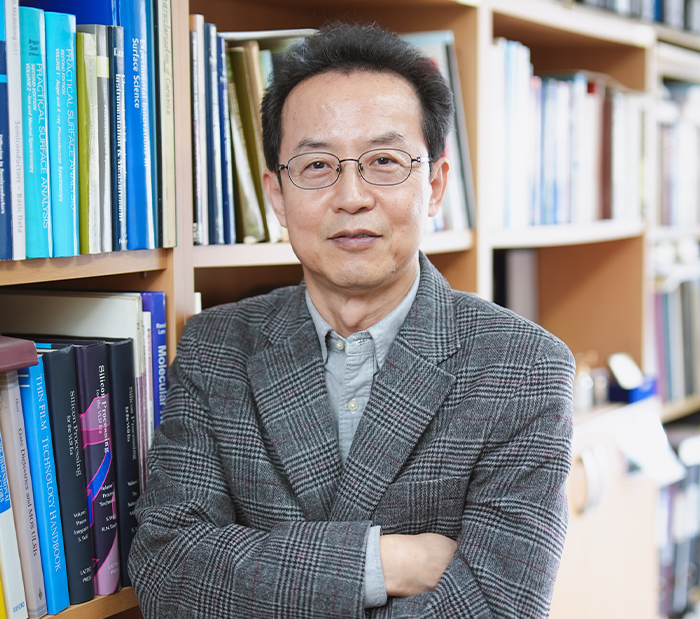Predicting and demonstrating of hidden metastable phase in transition metal oxide
Advanced Materials Science and Engineering LEE, JAICHAN Prof. · Bongwook Chung

-
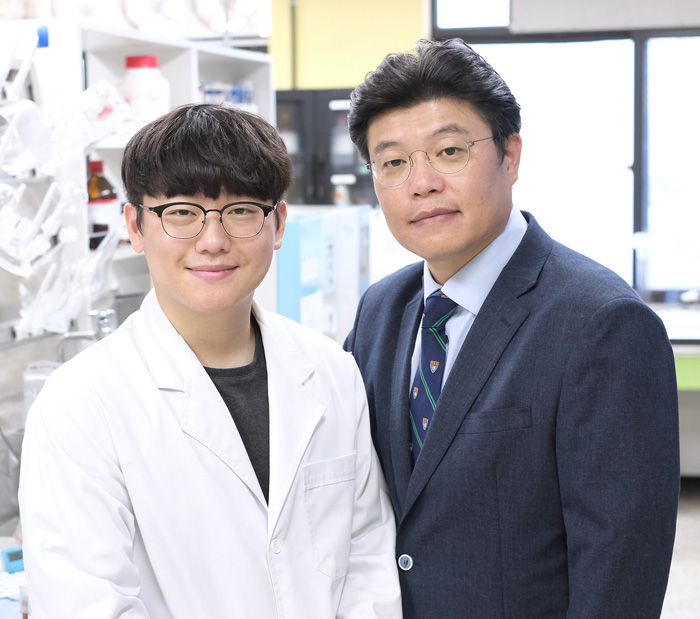
Chemical Engineering KIM, DONG HWAN Prof.
Discovery of a Novel Host Material to Obtain Highly Efficient Upconversion Luminescence at a Single-band Wavelength
Lanthanide trivalent ions (Ln3+) embedded in an inorganic host solid are capable of “upconversion”, which is the fascinating ability to convert multiple low-energy photons into a higher-energy photon. Upconversion luminescence suggests the promise of Ln3+-doped materials in emerging novel applications, such as energy harvesting for solar cells or deep tissue optogenetics. However, it has been difficult to further improve the upconversion efficiency because the upconversion efficiency and the upconversion emission spectrum are determined by the complex interaction between the host material and the lanthanide ion at an atomic level. Prof. Dong Hwan KIM, a professor at the Department of Chemical Engineering of SKKU, has developed the novel host material that does not have a short-range order (1st coordination order) by liquefying and quenching the host material using a laser, to maximize the host interactions, thus, realizing highly efficient upconversion luminescence at a single-band wavelength. The results of this study are significant not only in scientific fields but also in real world applications because the intrinsic limitations of the conventional host materials are overcome. This new material will be used in macroscale laser technologies and photonic integrated circuit devices. Please find out more details about this research from the published article: B. S. Moon, H. E. Kim and D. H. Kim, "Ultrafast Single-band Upconversion Luminescence in a Liquid-quenched Amorphous Matrix," Advanced Materials, 30, 1800008 (2018). (featured on the front cover)
- No. 90
- 2018-09-14
- 3531
-
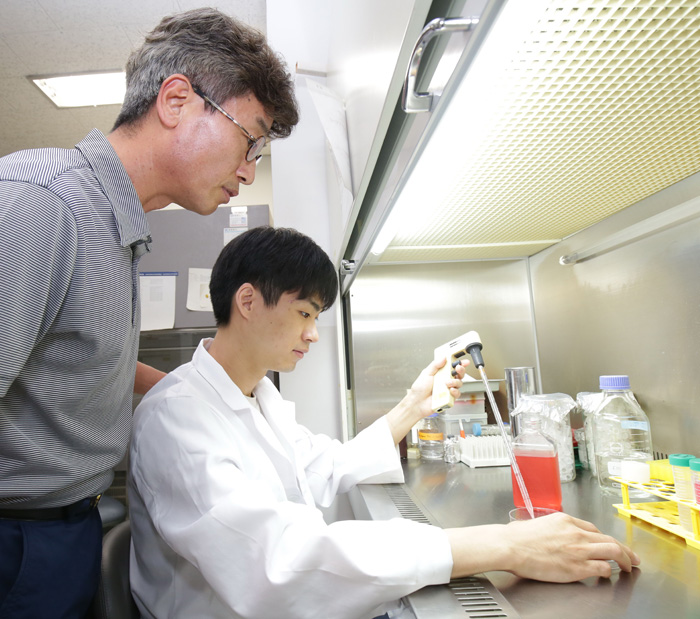
Medicine LEE, KI YOUNG Prof. ·Researcher MIN, YOON
Effect of Autophagy Regulated by Innate Signals on Cancer Progression
Prof. Ki Young LEE at School of Medicine published a research paper, "Inhibition of TRAF6 ubiquitin-ligase activity by PRDX1 leads to inhibition of NFKB activation and autophagy activation" in Autophagy, a highly prestigious journal (IF: 11.10). Autophagy is the natural, regulated mechanism used by cells to sequester, remove and recycle waste. Autophagy has roles in various cellular functions including nutrient starvation, infection, cellular repair mechanism, and programmed cell death, thereby functionally implicated in human diseases, such as cancer, infectious diseases, neurodegenerative diseases, liver diseases, diabetes. Pattern-recognition receptors (PRRs) are expressed by innate immune cells and recognize pathogen-associated molecular patterns (PAMPs) as well as endogenous damage-associated molecular pattern (DAMP) molecules, and play a crucial role in the proper function of the innate immune system. Recent studies have demonstrated that autophagy is extensively linked to innate immune signaling pathways mediated by toll like receptors (TLRs), which are a class of PRRs. Nevertheless, studies on the regulatory mechanisms of autophagy controlled by innate signals on cancer progression have yet to be investigated. Therefore, the objective of this study was to explore biological and functional roles of autophagy controlled by innate signals on cancer progression. In this study, the researchers provided two insights into the pivotal regulation of peroxiredoxin 1 (PRDX1), which is well known as one of intracellular antioxidant proteins, in toll like receptor 4 (TLR4)-mediated signaling and autophagy activation. Through the cellular and molecular studies, the researchers propose that PRDX1 protein is critically implicated in cancer progression through regulation of innate signal and autophagy activation, and suggest that the current results will contribute to our understanding of cancer development and progression in the future researches on various cancers. Fig. 1. The functional role of PRDX1 in autophagy activation in PRDX1-knockdown innate immune macrophages Fig. 2. Cancer invasive ability in PRDX1- knockdown MDA-MB-231 human breast carcinoma cells and PRDX1- knockdown SK-HEP-1 human hepatic adenocarcinoma cells
- No. 89
- 2018-09-04
- 3117
-
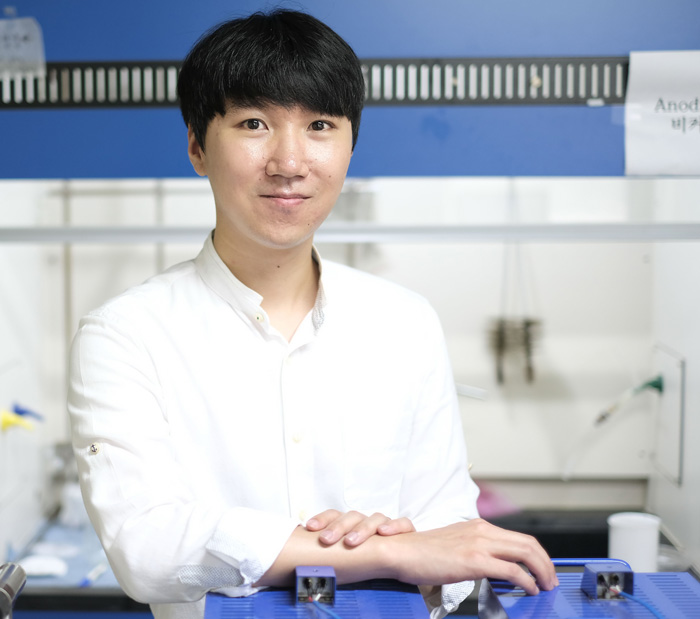
Advanced Materials Science and Engineering CHO, HYUNGKOUN Prof. ·Youngbeen Kim
Development of semiconductor photoanode material for hydrogen gas production
The article entitled “Electrochemical surface charge-inversion from semi-insulating Sb2Se3 photoanodes and abrupt photocurrent generation for water splitting” was published by Prof. Hyung Koun CHO and Youngbeen KIM (Integrated Ph. D program) at the Dept. of Energy & Environmental Science. Sb2Se3 with the 1.3 eV band-gap and native p-type characteristic is considered for the light harvester and absorption layer of the photovoltaic devices. However, the previous studies for PEC water splitting using pristine p-type Sb2Se3 have shown poor photocurrent and stability performances. Here, they found that the low PEC performance of the pristine Sb2Se3 is due to the energy band structure as a photocathode, so they designed new synthesis method to prepare n-type Sb2Se3 via controlling the origin of electrical conductivity. In this article, the study proposed the fabrication design of n-type Sb2Se3 photoanode with high photocurrent performance for photoelectrochemical water splitting cells at the first time based on the formation energy of the point defects determining the electrical conductivity. In particular, they electrochemically analyzed the origin of this explosive photocurrent generation and proposed the novel mechanisms using the typical capacitance concepts based on electrochemical analyses. As a result, the synthesized n-type Sb2Se3 exhibited the remarkable photocurrent density of 5 mA/cm2 from the photoanode for the first time.
- No. 88
- 2018-08-27
- 2708
-
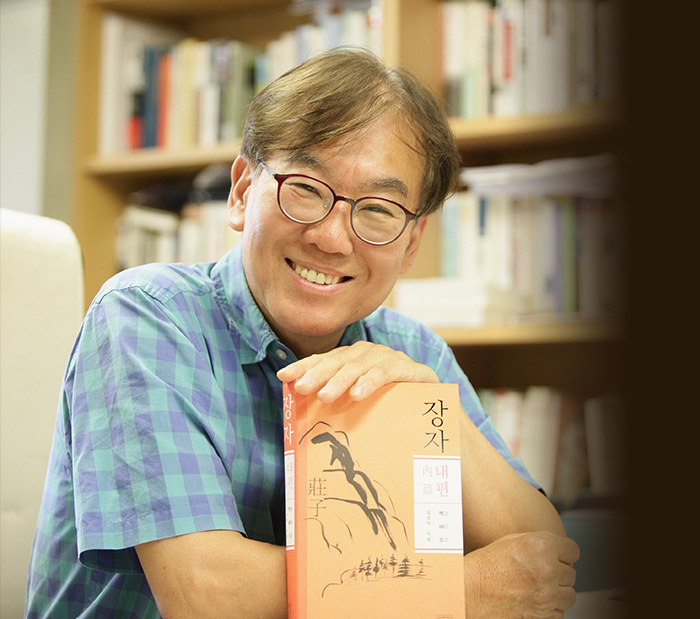
Journalism and Mass Communication KIM, JEONG TAK Prof.
Zhuangzi : The Inner Chapters
About this book In order to interpret the classics of East Asia, It needs to undergo five steps: 譯(translation), 注(pouring), 解(interpretation), 疏(communication), and 疏(discussion). 譯(Yeok) means the translation. However, just translating words are not enough to understand the classics of East Asia. Translation needs water as like we give water when rice planting. It makes writing alive. This is 注(Ju-pouring). 解(Hae) is interpretation. Even though the writing went through 譯 and 注, the sentences can still be very rough or tough. Therefore, interpretation is needed to figure out the right meaning of the writing, and this is 解. After 解, we need to find out what the content means to people today and this activity is called 疏. Lastly, Finally, The criticism should be done about this content and this is 疏(Non-discussion). These all five steps should be done to clarify the real meaning of the classics of East Asia. The Zhuangzi has 33 chapters, and it has been recognized for a long time that these chapters seem to fall into groups; within each group, the chapters share an intellectual outlook and certain textual features. However, only three groups are little different with other groups in their orientations. The first of these groups, chapters 1-7, forms the most coherent section of the text and many would argue that this is also the most philosophically interesting section as well. These are called the “Inner Chapters”; chapters 8-22 are called the “Outer Chapters”; “Inner Chapters” is consisted of “Free and Easy Wandering”, “Treatise on Making Things Equal”, “The Pivot of Nurturing Life”, “In the World of Man”, “The Mark of Utmost Virtue”, “The Prime Master”, and “In Response to High Kings”. “Free and Easy Wandering” is an introduction. “Treatise on Making Things Equal” is an theoretical base and the others are branches. Zhuangzi was carefully composed than any other hundred schools of philosophy books. It is the very important reason why we should take five steps before to understand. These sequences will lead reinterpretations of Zhuangzi.
- No. 87
- 2018-08-16
- 2770
-

Advanced Materials Science and Engineering KOTIBA, HAMAD Prof. ·Prof. JOO, JINHO
Polylactic Acid Blends: The Future of Green, Light and Tough
Prof. Kotiba HAMAD from School of Advanced Materials Science and Engineering published a review paper, “Polylactic acid blends: The future of green, light and tough”, in Progress in Polymer Science, a highly prestigious journal (IF: 24.558, Five years IF: 32.833). Polylactic acid (PLA) is a biobased product and biodegradable aliphatic polyester that has been studied for use in several applications over the last decade. Many properties of PLA, such as strength, stiffness, and gas permeability, have been found to be comparable to those of traditional petrochemical-based polymers. PLA-based materials, on the other hand, exhibit a number of limitations for specific applications, such as slow biodegradation rate, high cost, and low toughness. The frequent need for a modification of PLA by blending with other polymers to achieve suitable properties for its intended consumer and biomedical applications, accordingly, has demanded significant attention in the last decade (Fig. 1). This review is therefore designed to present a detailed overview of the preparation, characterization and applications of PLA blends and to provide information on the current status and future trends of these blends. Fig. 1. PLA polymer blend studies, as reported in Web of Science between 2007 and 2016. The review discussed the strategies used in processing and fabrication of PLA blends with biodegradable and non-biodegradable polymers. In addition, several concepts, such as structural, mechanical, rheological and thermal properties, biodegradability, and potentiality of these blends were outlined. The production of hierarchically porous materials using PLA blends for biomedical applications, such as tissue scaffolding was also introduced. The state of knowledge presented in this paper showed that the fabrication, properties and applications of PLA blends with biodegradable and non-biodegradable polymers will keep growing in the future. “This paper has been designed and presented to be a significant milestone in the future researches on PLA-based materials.” - Field of specialization: Advanced engineering materials - Publications: https://scholar.google.co.uk/citations?user=2qMywJ0AAAAJ&hl=en
- No. 86
- 2018-08-06
- 4403
-
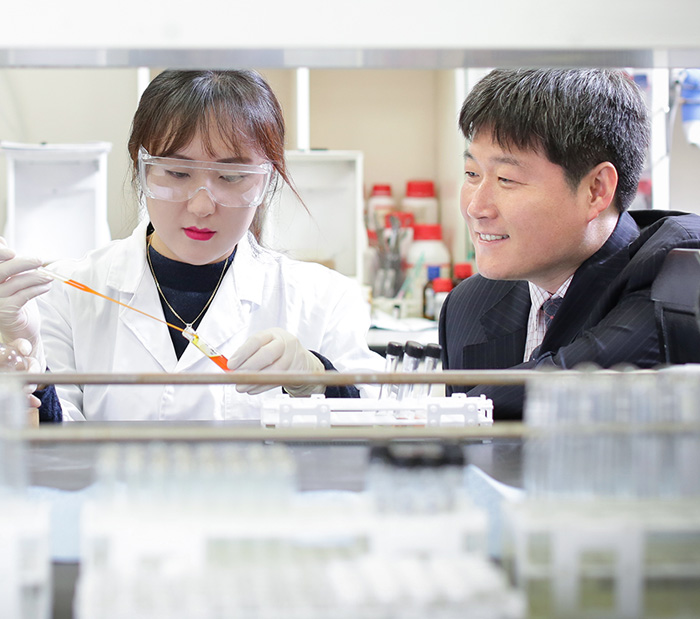
Pharmacy KIM, IN SU Prof.
A research group of Prof. In Su KIM decorated the cover paper of JACS
A research group of Prof. In Su KIM decorated the cover paper of JACS A research group led by Prof. In Su KIM, School of Pharmacy at Sungkyunkwan University, decorated the cover paper of ‘JACS (Journal of the American Chemical Society, IF: 13.858)’, which is the world's preeminent journal in chemistry, on the June. A research on artificial molecular computers that could mimic advanced functions in the cell signaling system is a global interest. The artificial computing systems perform various math functions based on electrical signals, but in vivo, their specific and advanced functions are realized through information processing of appropriate chemical signals. In particular, the cell signaling processes can communicate and synchronize each other in a precisely organized manner to implement their specific functions. As such, much effort has been devoted to developing artificial computing systems analogous to biological signaling processes. This research team first reports an artificial three-state molecular computer capable of performing advanced functions similar to those found in biological computing process. This was achieved by control of molecular recognition and three electronic states via ionic chemical stimuli. Especially, it was also demonstrated that the developed system conducted a cascade reaction for a high-valued organic chemical and functional polymer synthesis. It is also envisioned that artificial molecular computers mimicking the intravascular signaling system hold a great promise in developing smart drug delivery systems that would be used for early diagnosis and treatment of many important diseases. This research was supported by a Basic Research Laboratory (BRL) grant of the National Research Foundation of Korea (NRF) funded by the Korean government (MSIP).
- No. 85
- 2018-07-28
- 4091
-
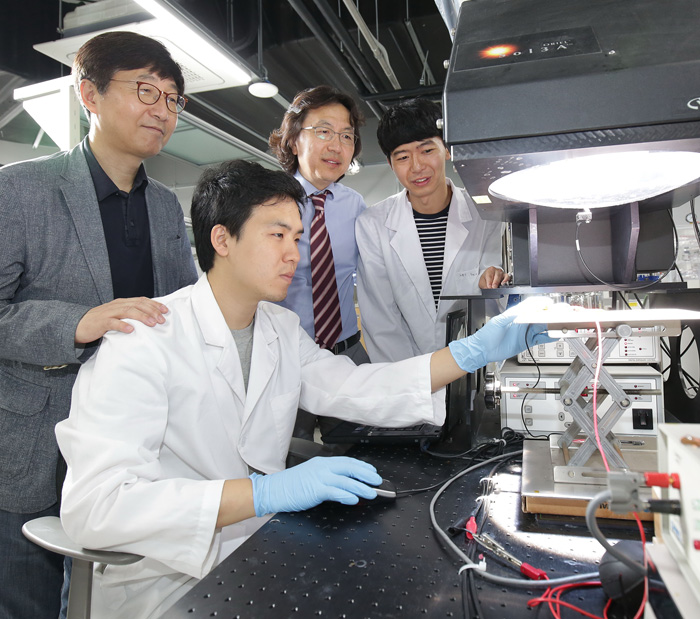
Energy Science SHIN, HYUN JUNG Prof.
Perovskite Solar Cells with Inorganic Electron & Hole Transport Layers Exhibit Long-Term Stability
Research groups from Sungkyunkwan University have recently reported that they developed highly stable perovskite solar cells under extreme environments by improving passivation techniques of perovskite solar cells. Perovskite is the name of a crystal structure, and for the perovskite solar cells, the materials refer to special compositional groups that have organic and inorganic halide ions. Perovskite solar cells have shown extremely rapid improvement of power conversion efficiency with low processing costs. However, the short-term lifetime of the device and the poor stability of the material under moisture, heat, light, and electrical biases remain to be overcome for commercialization. The architecture of the solar cells has inverted planar devices (so-called p-i-n devices; light illumination through hole transport layers) with FTO/NiO/Perovskite/PCBM/AZO/Ag. AZO has been deposited via atmoic layer deposition method, which produces pinhole-free, uniform, and dense films. The AZO-deposited perovskite solar cells exhibited similar performances to the control solar cells due to negligible charge transporting retardation by the 3 orders of magnitude higher conductivity of AZO compared to that of PCBM. The ALD-grown AZO (ALD-AZO) layers also acted as dense, uniform, and impermeable passivation layers that prevented ingress of water into the perovskite films, egress of the volatile components of perovskite when heated, and interfacial degradation between the perovskite-PCBM heterojunction and the Ag electrode caused by unfavorable chemical reactions. The authors found that the stability of perovskite solar cells with an AZO layer is superior to the control devices. While the control solar cells degraded rapidly under light illumination at room temperature in spite of an additional passivation layer, AZO-perovskite solar cells maintained 99.5% of their initial efficiency for 500 hours. The unique role of AZO, distinguished from additional passivating layers, is to prevent moisture penetration as well as interdiffusion at the perovskite/Ag interface when illuminated. These perovskite solar cells showed their stability in a more severe environment, exhibiting a power conversion efficiency of 18.45% and retaining 86.7% of their initial efficiency for 500 hours under continuous 1-sun illumination at 85°C in ambient air with electrical biases (at the maximum power point). This research on highly stable perovskite solar cells with inorganic charge transport layers has been published in Advanced Materials (IF 19.791) as an inside cover story by Prof. SHIN and Mr. SEO (Department of Energy Science) and Prof. PARK (School of Chemical Engineering) at Sungkyunkwan University. Published article: Seo, S., Jeong, S., Bae, C., Park, N.-G., and Shin, H., "Perovskite Solar Cells with Inorganic Electron- and Hole-Transport Layers Exhibiting Long-Term (≈500 h) Stability at 85°C under Continuous 1 Sun Illumination in Ambient Air.", Advanced Materials, 1801010 (2018).
- No. 84
- 2018-07-05
- 3348
-
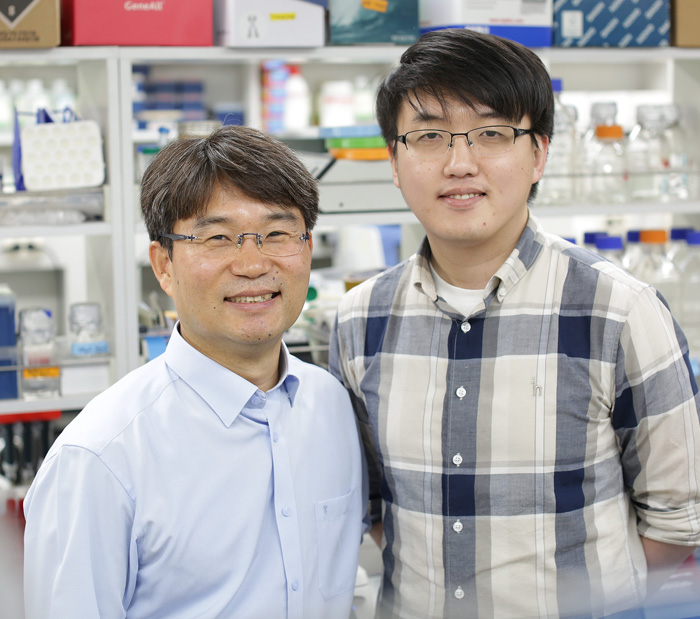
Biological Sciences YOON, HWAN SU Prof.
Identification of epigenetic gene regulation in the genome of marine seaweed by Prof. Hwan Su YOON
After completing the first human draft genome by the Human Genome Project (HGP) in 2003, many genome projects were initiated in the field of medicine and natural science. A genome is the total set of genetic information including all the genes of a living organism; therefore, if it is completely decoded, it will provide a lot of information about the function of the genes as well as the evolutionary relationship of living organisms. Recently, "Collaborative Genome Projects" have been launched by multiple ministries, and the Ministry of Oceans and Fisheries aims to decode genomes from 100 marine organisms. Professor Hwan Su YOON and his research group in the Department of Biological Sciences are leading the analysis of 30 marine algal genomes, including diverse seaweeds. As the first product, they completed the whole genome of Gracilariopsis chorda and published in "Molecular Biology and Evolution" (5 years IF 14.558). It is the second complete nuclear genome among approximately 7,000 red algal seaweed species. G. chorda is a popular edible seaweed for diet foods and salads, and it is also used in the agar production industry. From this paper, they generated a high-quality 92.1 Mb draft genome assembly from the red seaweed G. chorda, including methylation and small (s)RNA data. They analyzed these as well as other Archaeplastida genomes to address three questions: 1) What is the role of repeats and transposable elements (TEs) in the genome size variation of red algae, 2) what is the history of genome duplication and gene family expansion/reduction in these taxa, and 3) is there any evidence for TE suppression in the genome of red algae? See the details at the MBE journal website (https://doi.org/10.1093/molbev/msy081). Furthermore, Prof. YOON’s group has utilized the genome information to the application field. For example, the carbonic anhydrase of G. chorda shows much higher activities than that of humans. The carbonic anhydrase catalyzes the rapid interconversion of carbon dioxide and water to bicarbonate and protons (or vice versa); therefore, it could be used to remove carbon dioxide from polluted gases (collaborative research with Prof. Inhwan HWANG at POSTECH). In addition, with Prof. Jong Hwan KWAK in the department of Pharmacology, they found highly effective metabolic compounds for alleviating diabetes and arteriosclerosis from G. chorda. In this manner, the genomic information from marine algae is a valuable resource not only for academic but also industrial purposes. See Prof. YOON’s other research activities (http://bio.skku.edu/glter/wiki/Hwan%20Su%20Yoon)
- No. 83
- 2018-07-05
- 2688
-
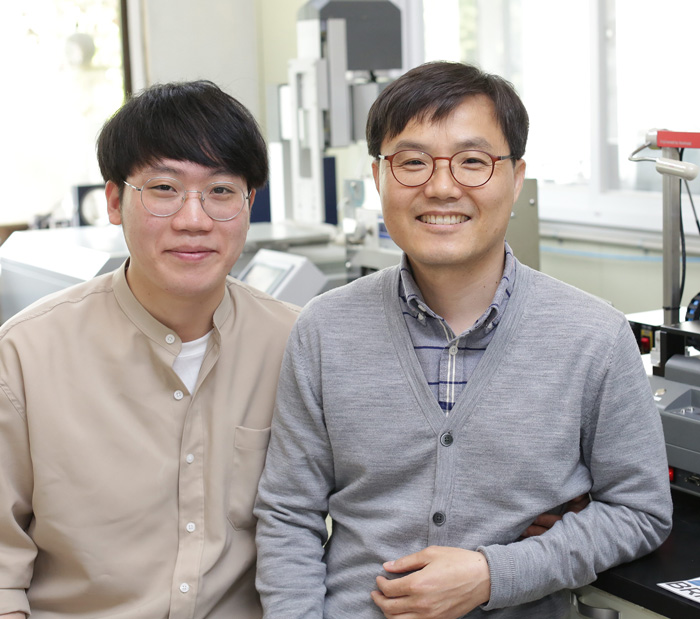
Bio-Mechatronic Engineering KIM, GEUNHYUNG Prof.
Research on Fabrication of Biomimetic Microfibril Structures using 3D Printing
In the human body, microfibril structures can be found in several types of tissue, such as muscles, nerves, and even tendons. In particular, muscle tissues have uniaxially-aligned microfibrous structures. The team (first author: Won Jin KIM) led by Geun Hyung KIM (Department of Biomechatronics Engineering at Sungkyunkwan University) fabricated a structure composed of bundled poly (e-caprolactone) (PCL) microfibers coated with collagen. To obtain the bundle of uniaxially-aligned (PCL) microfibers, 4D printing methods using a poly (vinyl alcohol) (PVA) fibrillation/leaching process were used. PVA was dissolved in distilled water to fibrillate the PVA. Then, PCL was added to the PVA solution and mixed. After mixing, the PVA/PCL mixture was printed using a 3D printer. The fabricated 3D structure was immersed in water to leach the fibrillated PVA. By using this simple fabricating method, a uniaxially micropatterned/fibrous PCL bundle was achieved. The fabricated structure was supplemented with collagen to increase the biocompatibility of the PCL bundle. The hybrid microfibrillated structure promoted myoblast proliferation and myogenic differentiation. “Due to the 4D printing process, it was able to have high efficiency in the fabrication of 3D scaffolds with highly aligned microfibrous bundles. In addition, a variety of designs and complex microscale-patterned 3D structures were constructed because of a highly versatile 3D printing method,” Prof. KIM said. Published article: W. Kim, M. Kim, G. H. Kim, Adv. Funct. Mater. 2018, 1800405. Article link: https://onlinelibrary.wiley.com/doi/epdf/10.1002/adfm.201800405
- No. 82
- 2018-07-05
- 2873
-

Energy Science SHIN, HYUN JUNG Prof.
Fabrication of a Stable New Polymorph Gold Nanowire with Sixfold Rotational Symmetry
Gold is the first metal used by humans, and it is deeply involved in human life. This was possible because gold was found to be almost pure in nature and easy to process without heating or melting. As one of the most chemically stable metals, gold adopts only one crystal structure. The crystal structure is closely related to the intrinsic properties of materials. When the crystal structure is changed, physical and chemical properties, including electrical and optical properties, are changed. Therefore, it is important to control the polymorphism to achieve reliable material or device properties. The crystal structure of gold is face-centered cubic (fcc) with 3-fold rotational symmetry by nature. For the first time, Prof. SHIN, Ms. LEE, and Dr. BAE (Department of Energy Science at Sungkyunkwan University) have published a stable hexagonal non-close packed structure (ncp-2H) of gold in Advanced Materials (IF 19.791) as a cover story. They report not only excelent stability of ncp-2H gold, but also different physical properties different from those of fcc. Schematic illustration of the experimental procedures for the confined growth of gold nanowires They fabricated the gold nanowires in a confined system of TiO2 nanotubes via the photoelectrochemical reduction of gold ions. During ultraviolet illumination, excited photoelectrons in the conduction band of TiO2 reduced the Au ions to metallic Au. At the early stage of the nucleation process, various polymorphs are able to be formed; however, they are eventually transformed to fcc, the most thermodynamically stable form in nature. They suggest that isolated ncp-2H gold seeds at the nucleation stage survive and grow by a diffusion-limited process under the nanoscale confinement provided by TiO2 nanotubes. They supported the possibility that nanoscale confinement influenced polymorph formation through control experiments. This study is particularly noteworthy that it suggests that different theories from that of classical thermodynamics are required for nanoscale confined systems. Published article: S. Lee, C. Bae, J. Lee, S. Lee, S. H. Oh, J. Kim, G.-S. Park, H. S. Jung and H. Shin, "Fabrication of a Stable New Polymorph Gold Nanowire with Sixfold Rotational Symmetry," Advanced Materials, 30, 1706261 (2018). (Cover Illustration)
- No. 81
- 2018-07-05
- 2263
-

Energy Science OH, SANG HO Prof.
Direct Imaging of Two Dimensional Electron Gas by Electron Holography
Atomically controlled interfaces of complex oxides provide new opportunities for materials design and synthesis. They have been the origin of a wide variety of new physical phenomena and properties, arising primarily from the natural quantum confinement of electrons at these interfaces, involving a strong correlation between the electronic and atomic structure. One notable example is the electronic reconstruction of the interface between insulating perovskite oxides that leads to the formation of an interfacial two-dimensional electron gas (2DEG). The 2DEG is known to be formed from the occupied 3d-orbitals of cations within a few nanometers of the interface and often involve an interplay of electronic states with distinct orbital character and symmetry. Different 2DEGs and the related properties are expected by the orbital-selective quantum confinement which is strongly correlated with the crystallographic orientation. Prof. Sang Ho OH of Department of Energy Science demonstrated that 2DEGs at oxide interfaces can be spatially mapped at subnanometer resolution using in-line electron holography and illustrated the power of this method by looking at the 2DEGs formed at (001) and (111) oriented LaAlO3/SrTiO3 interfaces and showing distinctly different spatial extent and charge density profiles across them. Prof. Sang Ho Oh and his Ph.D. student, Dr. Kyung Song now at KIMS, have successfully calibrated all variables affecting the 2DEG distribution, for example, the sample thickness, the mean inner potential and permittivity (ε), and thereby extracted intrinsic properties of 2DEG. Especially, taking account of the nonlinearity of the permittivity of oxide with electric field is essential, as the presence of the 2DEG leads to strong electric fields near the interface where the 2DEG is confined. The field-dependent permittivity has been calculated via analytical approach based on Landau theory and also directly through DFT calculation. These results provide the first direct evidence of the control of 2DEG properties through the interface orbital configuration and reveal the unprecedented capability of in-line holography to probe oxide heterostructures. According to Prof. OH, the electron holography technique developed in the present work will play an important role in development of future oxide-based electronic devices as it is a unique tool bridging various emergent properties arising from quantized electrons at interfaces, such as ferromagnetism, superconductivity and metal-insulator transition, with the function and performance of devices. The work has been conducted through international collaboration with Prof. Chang-Beom EOM, Prof. Christoph KOCH, Prof. Mark RZCHOWSKI and Prof. Evgeny TSYMBAL, Prof. Young-Min KIM and Prof. Si-Young CHOI and published recently in the March issue of Nature Nanotechnology. A companion paper has been published back to back in Nature Materials, demonstrating the formation of two-dimensional hole gas (2DHG) at the p-type LaAlO3/SrTiO3 interface. The work has been supported by National Research Foundation (NRF) of Korea and AFOSR Asian Office of Aerospace Research and Development (AOARD).
- No. 80
- 2018-07-05
- 2524
-

SKKU Advanced Institute of Nano Technology LIM, YONGTAIK Prof.
Prof. Yong Taik LIM Develops Implantation of Synthetic Immune Niche that Prevents Tumor Recurrance
Cancer vaccines are an attractive option for improving disease-free survival following surgical resection of solid tumors. However, several clinical studies have shown that while cancer vaccines can routinely induce protection in a prophylactic model, the same vaccines often show only limited therapeutic efficacy. The tumor immunosuppressive network, formed by interactions between cancer cells and host immune cells, is a major obstacle to achieving complete tumor eradication. Myeloid-derived suppressor cells (MDSCs) can be considered critical players in tumor-induced immunosuppression in both animal models and cancer patients, which they have a remarkable ability to suppress the activation and proliferation of T cells. Therefore, the depletion of MDSCs would strengthen immunity of tumor-bearing mice. Recently, Prof. Yong Taik LIM’s group of Sungkyunkwan University reported a novel implantable, engineered 3-dimensional porous scaffolds which were designed to generate synergistic action between MDSC-depleting agents and cancer vaccines consisting of whole tumor lysates and nanogel-based adjuvants. The local peritumoral implantation of the synthetic immune niche (termed immuneCare-DISC, iCD) as a post-surgical treatment in an advanced-stage primary 4T1 breast tumor model generated systemic anti-tumor immunity and prevented tumor recurrence at the surgical site as well as the migration of residual tumor cells into the lungs, resulting in 100% survival. These therapeutic outcomes were achieved through the inhibition of immunosuppressive MDSCs in tumors and spleens by releasing gemcitabine and recruitment/activation of dendritic cells, enhanced population of CD4+ and CD8+ T cells, and increased IFN-γ production by cancer vaccines from the iCD. This combined spatiotemporal modulation of tumor-derived immunosuppression and vaccine-induced immune stimulation through the iCD is expected to provide an immune niche for preventing of postoperative tumor recurrence and metastasis.
- No. 79
- 2018-07-05
- 2319


